November 2014
For the Love of Art
M – Marble Painting
Materials: marbles, cups of paint, spoons, paper, cardboard box
 Directions: Cut paper to fit in the bottom of the box. Drop marbles in the cups
of paint. With a spoon, remove the marbles and place them in the
box. Tilt the box, rolling the marbles around to make a design.
Directions: Cut paper to fit in the bottom of the box. Drop marbles in the cups
of paint. With a spoon, remove the marbles and place them in the
box. Tilt the box, rolling the marbles around to make a design.
Adaptations: Roll paper and place it inside a cheese ball container or similar
cylinder. Drop jingle bells in paint, then spoon into the container.
Put on the lid and shake. (Sing “Jingle Bells” as you shake.)
Remove paper to see the jingle bell painting.
Use golf balls, rocks, and other objects to paint in a similar way.
More! Put a little water in a cup and add a squirt of food coloring. Let
children dip marshmallows in the colored water and print on paper
for M. Clean up is easy! MMMMM!
N – Negative Space
Materials: crayons, scissors, paper

Directions: Have children cut a hole out of the middle of a sheet of paper. Can they
draw a picture incorporating the hole (“negative” space)?
Adaptations: Let children tear holes out of a sheet of paper and exchange papers with
a classmate.
Use markers or paints to create objects around the hole.
More! You can also do nature prints for N by printing with leaves, feathers, and
other natural objects.
O – Oil and Water
Materials: dry tempera, vegetable oil, tub of water, spoons, paper

Directions: Mix one heaping teaspoon of powdered paint with 1/3 cup vegetable oil.
(I like to use green and blue for this project because it looks like the earth.)
Fill the tub half full with water and dribble a little paint on the surface. Hold
the paper in both hands and gently lay on the water and then lift it off. Dry.
P – Point Prints
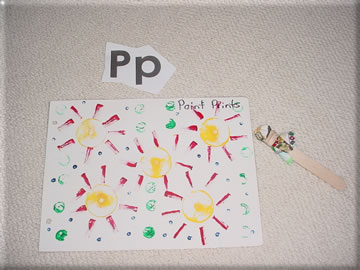
Materials: paint, paper plates, pencils with erasers, wooden dowels, and other objects
with points, paper
Directions: Pour a small amount of paint in each paper plate. Children take the erasers,
blocks, etc. and dip them in the paint and print on the paper.
Adaptations: Challenge children to reproduce a pattern with their points.
Make “pouncers” for printing. Put a cotton ball on the end of a craft stick
and cover with a small piece of fabric. Wrap a rubber band around it to
make a ball. Dip in paint and “pounce” on a piece of paper!
Q – Tip Painting
Materials: Q-tips, paint, paper, cups
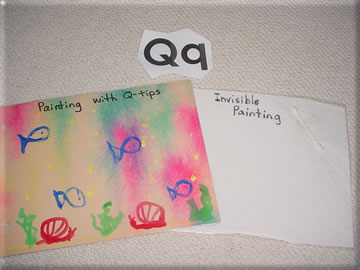
Directions: Put a little paint in the cups. Dip the ends of cotton swabs in paint
and use as brushes.
Adaptations: Mix food coloring with a small amount of water and paint with Q-tips
on paper towels.
Do invisible paintings by dipping Q-tips in water and painting on a
paper towel.
R – Rubbings
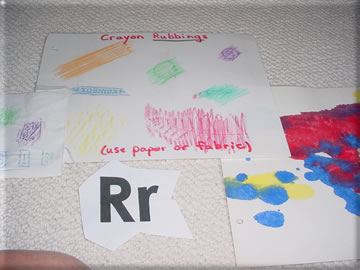
Materials: crayons, paper, textured objects (coins, leaves, sandpaper, comb, etc.)
Directions: Tear outer paper from crayons. Place the paper over the textured object.
Rub with the side of the crayon in one direction to make the image appear.
Adaptations: Make nature rubbings on the playground of tree bark, rocks, flowers, etc.
Make rubbings of puzzles and other school objects.
S- Sponge Prints
Materials: sponges, scissors, paint, paper plate paper
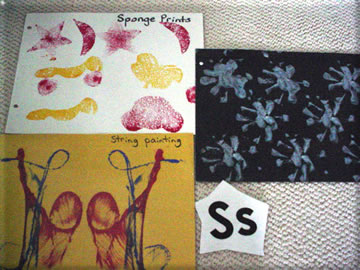
Directions: Cut sponges into shapes letters, or seasonal objects. Pour a small
amount of paint on the paper plate. Dip the sponge in the paint and
press on the paper.
Adaptations: Use a sponge ball or dish mop to make prints.
Make wrapping paper by sponge painting on tissue paper or bulletin
board paper.
More! Do string painting for S. Dip ends of string in cups of paint. Fold a
sheet of paper in half and place strings on the paper. Pull strings to
create a design.
T- Torn Paper Collage
Materials: scrap paper, glue, construction paper.
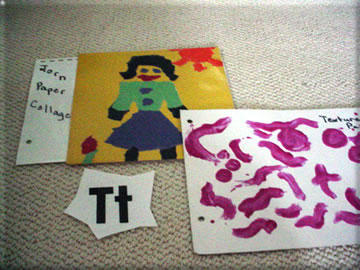
Directions: Use fingers like scissors to tear scrap paper into little pieces. Glue
them to the paper to make a design or picture.
Adaptations: Cut paper into seasonal shapes, such as eggs or leaves.
Add details with crayons or markers.
More! Make textured paint for T. Mix equal amounts of flour and salt.
Stir in liquid paint to make a thick texture. Apply to paper with
a brush or fingers.
U – Underwater Picture
Materials: crayons, paper, diluted blue tempera paint, large paint brush

Directions: Challenge children to draw an “underwater” picture with the crayons.
(Press hard with the crayons to apply a generous amount of color.) “Wash”
over the entire page with paint. The areas covered by the crayon will
“resist” the paint.
Hint! This works best if you just mix a little paint with the water.
V – Vegetable Prints
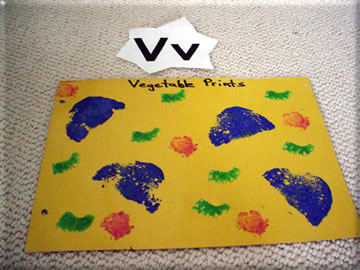
Materials: carrots, celery, green pepper, okra and other firm vegetables and
fruits, paint, paper plate, paper towels, paper
Directions: Cut fruits and vegetables in half diagonally. Drain on a paper towel
to eliminate excess juice. Put paint in the paper plate. Dip
vegetables in the paint and press on the paper.
Adaptations: Cut a potato in half. Carve out a design from the end section of the
potato. Drain, dip in paint, and print.
W – Wheel Painting
Materials: toy cars, trucks, and other vehicles with wheels, paint, paper, paper
plates
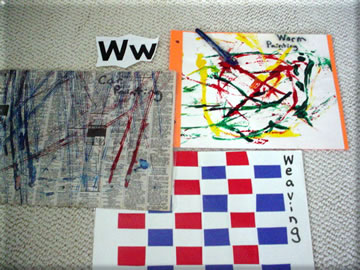
Directions: Put a small amount of paint in the paper plates. Dip the wheels of the
vehicles in the paint, and then “drive” them across the paper.
Hint! This is more fun with large sheets of paper.
More! You can also do weaving for W.
Here’s another fun art activity for W. Give children rubber fishing
worms and dip them in paint. Wiggle across a sheet of paper to make
designs.
X – Marks the Spot
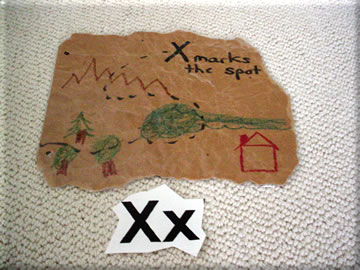
Materials: brown paper grocery bags, crayons or markers
Directions: Cut paper sacks into 8” x 10” sections. Have children wad up the sacks
and squish them until they look like old parchment. Children put an “X” on
their paper and then draw a treasure map with crayons or markers.
Y – Yarn Designs
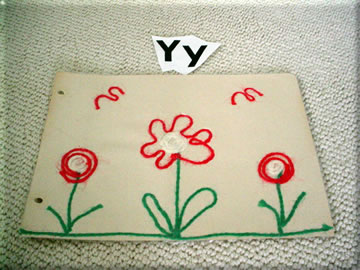
Materials: colorful yarn, glue, paper
Directions: Children create designs with glue and then place yarn on top.
More! Make slits in the sides of a paper plate. Children weave through slits
with yarn or string to make designs.
Z – Zigzag Art
Materials: crayons, paper
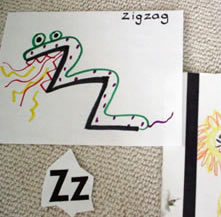
Directions: Make zigzag lines on paper. Challenge children to create something
out of the zigzags.
Adaptations: Have children close their eyes and make wiggles and squiggles. Exchange
papers with a friend and decorate with markers and crayons.
More! You can also draw zoo animals for Z. Glue on strips of black paper to
resemble a cage.
First Page
 Directions: Cut paper to fit in the bottom of the box. Drop marbles in the cups
of paint. With a spoon, remove the marbles and place them in the
box. Tilt the box, rolling the marbles around to make a design.
Directions: Cut paper to fit in the bottom of the box. Drop marbles in the cups
of paint. With a spoon, remove the marbles and place them in the
box. Tilt the box, rolling the marbles around to make a design.











